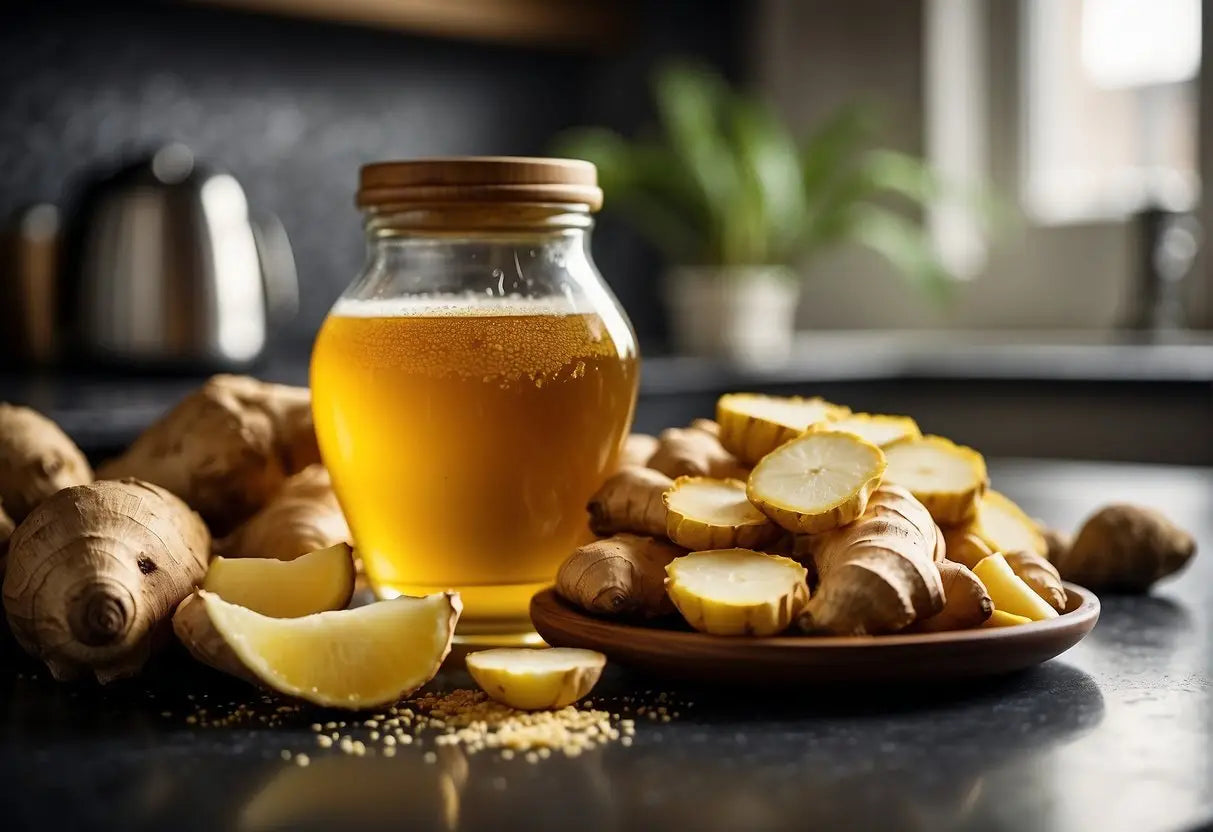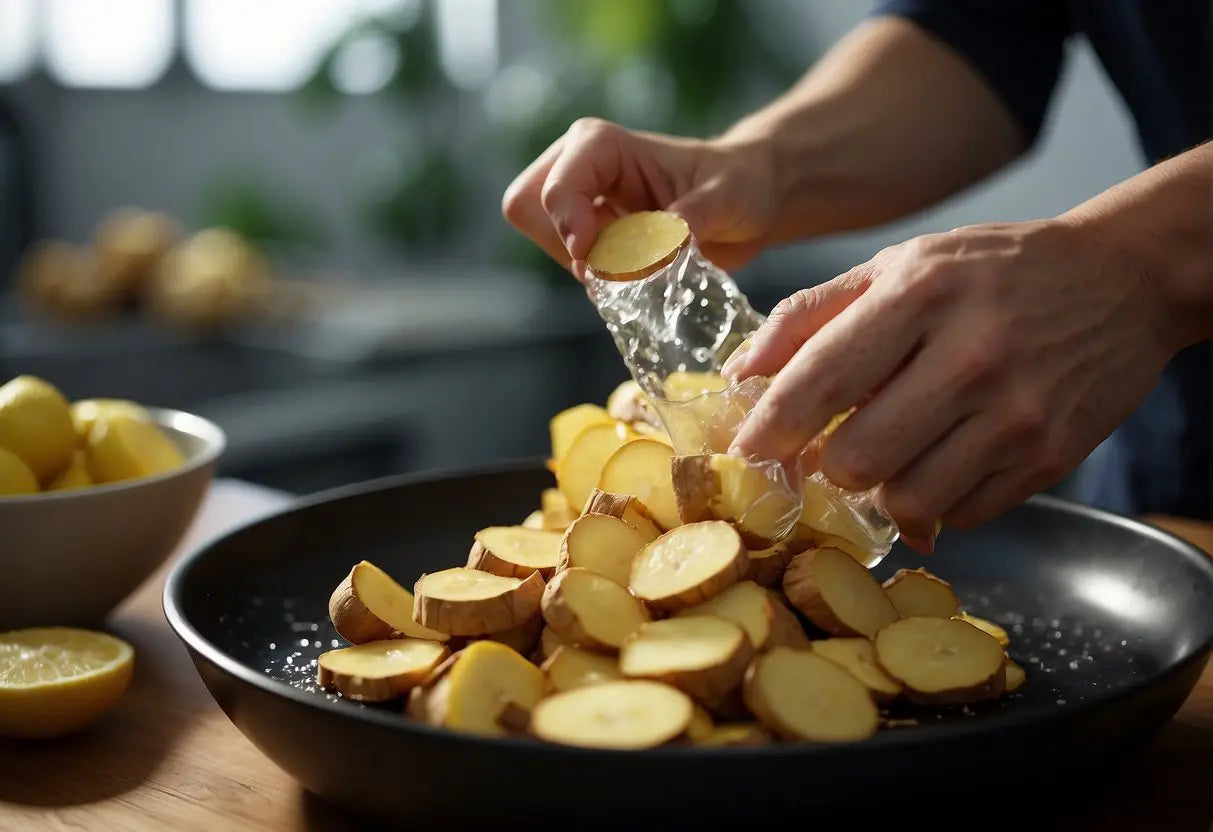How to Make Ginger Tea
Ginger tea is renowned for its potential health benefits, which you might find appealing. Here's a concise overview of some of the advantages:
- Digestive Health: It's known to soothe the digestive system, which can help relieve nausea, including morning sickness and chemotherapy-related nausea.
- Anti-inflammatory: The active component in ginger, gingerol, has anti-inflammatory properties that may reduce muscle pain after exercise.
- Immune Support: Ginger has immune-boosting effects that could help fend off colds and the flu.
- Cholesterol Levels: Some studies suggest that ginger tea may influence cholesterol levels, potentially reducing the risk of heart-related issues.
Here is a simple table summarizing these points:
| Benefit | Description |
|---|---|
| Digestive Health | Helps relieve various forms of nausea and soothes digestion. |
| Anti-inflammatory | May reduce inflammation and muscle pain post-exercise. |
| Immune Support | Boosts immunity and may help combat colds and the flu. |
| Cholesterol Levels | Can impact cholesterol levels, promoting heart health. |
Keep in mind that while ginger tea can be a healthy addition to your diet, you should consult your healthcare provider before making significant changes, especially if you're pregnant, nursing, or have medical conditions. It's also important to note that these benefits can vary from person to person and more research is always underway to fully understand ginger's effects on health. Drink ginger tea in moderation and enjoy the warm, spicy flavor it adds to your day.
Bestsellers
Selecting Quality Ginger
When making ginger tea, the quality of the ginger you use will greatly affect the flavor and potential health benefits. It's crucial to understand the differences between fresh and powdered ginger as well as organic and non-organic options.
Fresh vs. Powdered Ginger
-
Fresh Ginger:
- Appearance: Look for ginger root that is firm to the touch with a smooth, taut skin.
- Aroma: Fresh ginger should have a sharp, pungent scent.
- Shelf life: Lasts up to three weeks in the refrigerator.
-
Powdered Ginger:
- Color: Seek out vibrantly colored ginger powder, which is indicative of freshness.
- Taste: Test for a spicy, robust flavor, as stale ginger powder may taste dull.
- Shelf life: Can be stored for up to four years in a cool, dark place.
Organic vs. Non-Organic
-
Organic Ginger:
- Pesticides: Grown without synthetic pesticides or fertilizers.
- Certification: Look for an official organic certification label.
-
Non-Organic Ginger:
- Price: Generally less expensive than organic ginger.
- Availability: More widely available in conventional grocery stores.
Ginger Tea Ingredients

Crafting the perfect cup of ginger tea begins with understanding your ingredients. Their quality and proportions lay the foundation for the final flavor.
Ingredient List
Your basic ginger tea requires only a few essential items:
- Fresh ginger root: Typically, about 2 inches of ginger root is sufficient for making two servings.
- Water: You'll need 2 cups, which equals approximately 500 milliliters, to steep your ginger in.
- Honey or sweetener (optional): Adjust the amount to taste, but a teaspoon is a good starting point.
- Lemon juice (optional): A squeeze of lemon juice, around a tablespoon, can enhance the tea's flavor.
Ingredient Substitutions
Should you find yourself without fresh ginger or wish to tailor the tea to your taste, here are substitutions to consider:
- Dry ginger powder: Use 1/4 teaspoon to replace the fresh ginger root.
- Maple syrup or agave nectar: These can substitute honey as a sweetener.
- Lime juice: If you don't have lemon juice, lime juice offers a similar citrusy dimension.
- Mint leaves: Add a few leaves to introduce a refreshing twist.
Preparation Tools
When making ginger tea, having the right tools on hand streamlines the process and ensures a pleasant brewing experience.
Kitchen Utensils Needed
- Knife: A sharp knife is essential to peel and slice the ginger root.
- Grater/Zester: Use this to grate fresh ginger if you prefer a stronger infusion.
- Measuring Spoons: These will help you measure the amount of ginger and other optional ingredients like honey accurately.
- Saucepan: Needed to boil the water and steep the ginger.
- Spoon/Stirrer: To mix and taste your tea as it steeps.
Serveware Options
- Teapot: A teapot with an infuser is perfect if you plan to make more than one cup of ginger tea.
- Mug: Individual mugs work well for single servings, preferably with a handle to avoid burns.
- Strainer: If you don’t have an infuser, a strainer will help filter out ginger pieces from your tea as you pour it into the mug.
Ginger Tea Brewing Techniques
Selecting the right brewing method for ginger tea can greatly enhance its flavor and health benefits. Here are three popular methods, each providing a unique taste experience.
Traditional Boiling Method
To extract the bold and robust flavors from ginger, boil water in a pot. Cut approximately one inch of fresh ginger root into thin slices or grate it. Once the water is boiling, add the ginger and let it simmer for about 15-20 minutes. Strain the pieces out before serving.
Infusion Method
For a gentler flavor, the infusion method works best. Boil water and add it to a cup containing a few slices of ginger. Cover and let it steep for about 5-10 minutes. Removing the ginger slices at the desired time will prevent the tea from becoming too strong.
Cold Brew Method
If you prefer a milder tea with subtle ginger notes, opt for the cold brew method. Combine thinly sliced ginger and cold water in a jug. Let it sit in the refrigerator for at least 12 hours. This process creates a refreshing beverage that's perfect for warm days or as a cold remedy.
Flavor Enhancements

Enhancing the flavor of your ginger tea can elevate it from a simple infusion to a complex and satisfying beverage.
Lao Ban Zhang
Optional Add-Ins
To diversify the taste and add depth to your ginger tea, consider incorporating these ingredients:
- Mint: Adds a refreshing twist
- Lemon slices: Contributes a tangy zest
- Cinnamon sticks: Provide warm, aromatic notes
Sweetening Choices
Choosing the right sweetener can complement the robust flavor of ginger:
- Honey: Offers a natural sweetness with floral undertones
- Maple syrup: Gives a distinctive, rich sweetness
- Sugar: A classic sweetener; available in white, brown, or raw varieties
Serving Suggestions

When serving ginger tea, the right presentation and food pairings can elevate the drinking experience. Follow these tips to impress your guests or to simply enjoy your tea time to the fullest.
Presentation Tips
- Use transparent glassware to showcase the vibrant color of the tea. A clear glass mug or teapot allows the golden hue to shine through.
- Garnish with a thin slice of fresh ginger or a sprig of mint on top of the cup for a visually appealing and aromatic touch.
- For sweetener, present honey, lemon slices, and rock sugar on the side in small bowls, giving guests the option to customize the taste to their preference.
Pairing with Foods
-
Savory Snacks: Ginger tea pairs well with light savory snacks such as crackers with cheese or rice cakes topped with avocado.
Snack Type Suggested Pairing Crackers Mild Cheddar Cheese Rice Cakes Mashed Avocado Mini Sandwiches Cucumber and Dill -
Sweet Treats: Complement the spicy notes of ginger tea with biscuits, scones, or sweet breads.
Sweet Type Suggested Pairing Biscuits Lemon Drizzle Scones Clotted Cream & Jam Sweet Breads Banana Walnut -
Enjoy the contrast in flavors by pairing the ginger tea with dark chocolate, whose rich bitterness harmonizes with the tea's sharpness.
Remember, these suggestions are intended to complement the ginger tea rather than overpower it. Adjust according to your taste preferences.
Health Considerations
Ginger tea can be a beneficial addition to your diet; however, it's important to be aware of potential health considerations.
Ginger Allergy Advice
Be mindful of the possibility of a ginger allergy. Symptoms of a reaction include:
- Itching or swelling of the mouth
- Hives or skin rash
- Gastrointestinal discomfort
If you experience any of these symptoms, discontinue use and consult a medical professional.
Consulting Healthcare Providers
Before adding ginger tea to your regimen, particularly if you have medical conditions, speak with your healthcare provider. Points to discuss include:
- Interaction with medication
- Impact on existing health conditions such as blood disorders or pregnancy
- Appropriate dosage for your individual needs
Storage and Freshness
Proper storage of fresh ginger and understanding tea shelf life are crucial for maintaining the quality and flavor of your ginger tea.
Storing Fresh Ginger
To ensure that the ginger root you use for your tea remains fresh, store it in the refrigerator in a plastic bag with the air pushed out. Fresh ginger can last up to three weeks when stored this way. If you prefer to keep it for a longer period, peel the ginger root, slice it, and submerge the pieces in a jar of vodka or sherry. In the refrigerator, this method can preserve your ginger for several months.
Tea Shelf Life
Once you have brewed your ginger tea, it can be stored in the refrigerator for up to three days. Ensure you place the tea in an airtight container to preserve its freshness. It's important to note that the longer the tea sits, even in the fridge, the more the flavors will diminish. For the best taste, consume your homemade ginger tea within 24 hours of brewing.
Ginger Tea Variations

Exploring ginger tea variations allows you to enjoy this warming beverage in ways that cater to regional tastes and dietary needs.
Regional Recipes
Masala Chai (India): Add grated ginger to a pot with black tea leaves, cardamom, cloves, cinnamon, and milk. Sweeten with sugar or honey to taste.
Saenggang Cha (Korea): Combine fresh ginger juice, Korean honey or corn syrup, and a pinch of cinnamon in hot water.
Dietary Adaptations
Vegan Ginger Tea: Use plant-based milk like almond or soy, and sweeten with agave syrup or maple syrup instead of honey.
Low-Sugar Ginger Tea: Brew your ginger tea with fresh lemon juice and a stevia leaf or a small amount of a sugar substitute to reduce sugar content.
Frequently Asked Questions
In this section, you'll find concise answers backed by current knowledge for the most common inquiries about ginger tea, particularly regarding its preparation and potential health benefits.
What are the benefits of drinking ginger tea for weight loss?
Ginger tea might enhance your body's metabolic rate, which can aid in the weight loss process. However, it should complement a balanced diet and regular exercise for effective results.
Can ginger tea help alleviate cough symptoms?
Yes, ginger tea is known for its anti-inflammatory properties and can help soothe a sore throat and reduce coughing.
What's the correct way to prepare ginger tea using ground ginger?
To prepare ginger tea with ground ginger, mix a 1/4 teaspoon of ground ginger with hot water. Let it steep for about 10 minutes, then strain if desired and enjoy.
How do you incorporate milk into ginger tea preparation?
To add milk to ginger tea, brew the tea as usual and then add a splash of warm milk to taste. Stir well before drinking.
Is ginger tea effective for managing symptoms of acid reflux?
Ginger tea may help alleviate symptoms of acid reflux due to its gastrointestinal soothing effects. However, results can vary, so monitor your body's response.
What are the advantages of consuming ginger tea during a cold?
Drinking ginger tea during a cold may help boost your immune system and relieve congestion, due to its warming and anti-inflammatory properties.
← Older post Newer post →











